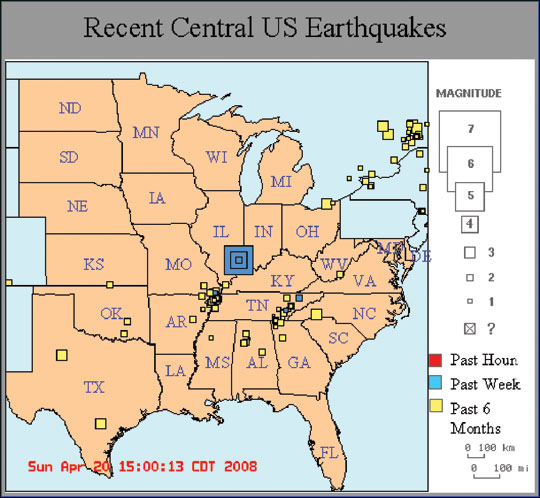 USGS
USGSCorrection Appended
As students slept Friday morning, a 5.2 magnitude earthquake rumbled through Washington University and the Midwest, shaking a community rarely affected by such occurrences.
Despite the numerous construction sites on campus, Assistant to the Chancellor Rob Wild said that the University sustained no damage.
“On Friday, following the earthquake and the aftershock, we began conducting an inspection of all of our buildings and still at this point have found no damages or reports of major damages,” Wild said. “We’ve done a pretty extensive inspection at this point and will continue over the next week.”
According to the University’s Facilities Planning Manager Bill Wiley, the buildings on campus are up to code and the University was prepared for the earthquake.
“We are in the new magnitude area so there is quite a bit of consideration for this,” Wiley said.
According to the St. Louis Post-Dispatch, the earthquake resulted from two tectonic plates along the New Madrid fault line moving apart. The New Madrid fault line is a seismic zone covering areas in Illinois, Kentucky, Arkansas, Tennessee and Missouri.
The earthquake and its subsequent aftershock, of 4.5 magnitude, did not originate from the main fault line along the Mississippi River, however, but rather from another area of seismic activity called the Wabash Valley Seismic Zone.
There are no reported injuries and Dave Overhoff, a geologist with the Missouri Department of Natural Resources, said this was not a major earthquake. However, it serves as a warning, and reiterates the importance of researching the New Madrid fault line.
“It kind of borders on the small to moderate earthquake, but what it does is increases awareness and makes people realize there is an earthquake threat in the center of the continent, even if we don’t understand how that works,” Overhoff was quoted saying in the Post-Dispatch article. “People have to understand that threat is there and prepare for it.”
Although the earthquake’s epicenter was located in Bellmont in southeastern Illinois, 127 miles east of St. Louis, most students felt the shocks of the earthquake.
Sam Kentor, a freshman from Texas, said he was frightened by the violent shaking that woke him up at 4 a.m.
“My only experience with earthquakes was with ‘The Land Before Time.’ I thought my dorm was going to fall into the depths of the earth,” Kentor said.
Katy Southworth, a freshmen living on the South 40, said the noise of her door banging woke her up, rather than the actual earthquake.
“I didn’t realize it was an earthquake until I went to class and we talked about it in class,” Southworth said.
According to the Web site of the Washington University Police Department (WUPD), in preparation for an earthquake students should secure appliances and shelves and remove any heavy objects from shelves above head level. Students should also locate beds away from windows and heavy objects.
During earthquakes students should remain calm and, if indoors, should go under a table or bed or stay in a narrow hallway. If outside, WUPD advises students to move away from buildings, wires, trees and utilities.
Correction: An article on Monday, April 21 mistakenly referred to the Wabash Valley Seismic Zone as a part of the New Madrid Fault Line. In reality, the Wabash Valley zone is a separate region of tectonic activity. In addition, the article misspelled the name of the town at which the epicenter was located; it is Bellmont, not Bellmount.